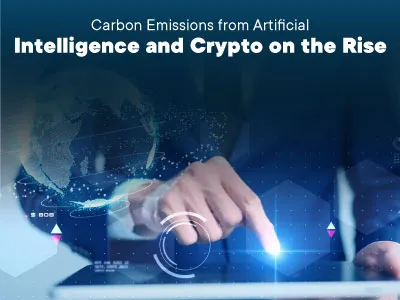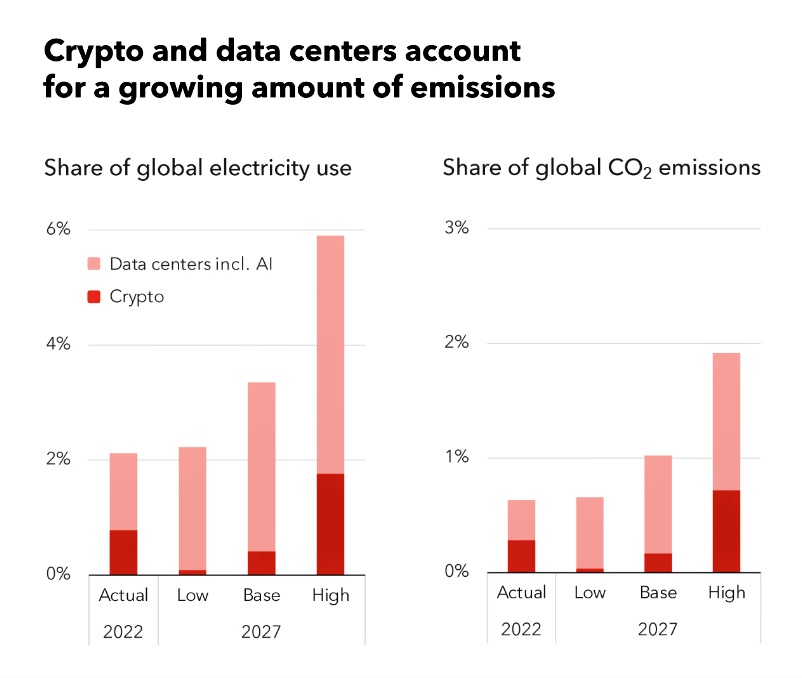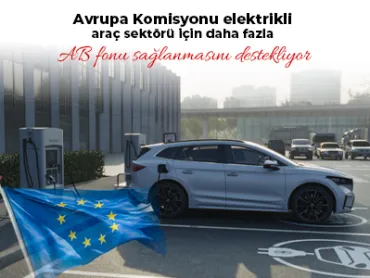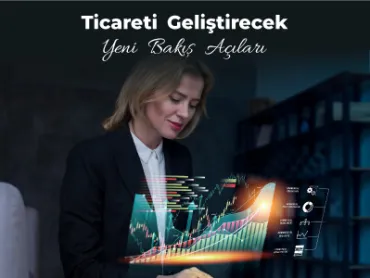
Crypto mining and data centers now account for 2 percent of global electricity use and about 1 percent of global emissions, while their carbon footprint is growing.
So what do cryptoassets and AI have in common? Both are power-hungry.
A Bitcoin transaction requires roughly as much electricity as the average person in Ghana or Pakistan consumes in three years, due to the high amount of electricity already used by powerful equipment to “mine” cryptoassets, while ChatGPT queries require 10 times more electricity than a Google search, due to the electricity consumed by AI data centers.
As the graph below shows, crypto mining and data centers together accounted for 2 percent of global electricity demand in 2022. According to estimates based on projections from the International Energy Agency, this share is likely to increase to 3.5 percent within three years. This would be equivalent to the current consumption of Japan, the world's fifth-largest electricity user.

The climate impacts of these activities (regardless of their social and economic benefits) are a cause for concern. A recent IMF report found that crypto mining could account for 0.7 percent of global carbon dioxide emissions by 2027. Extending the analysis to data centers (based on IEA estimates) means that carbon emissions could reach 450 million tons by 2027, or 1.2 percent of the world's total.
The tax system is one way to encourage companies to reduce emissions. According to IMF estimates, a direct tax of $0.047 per kilowatt-hour would drive the crypto-mining industry to reduce emissions in line with global targets. If the impact of air pollution on local health is also taken into account, this tax rate would rise to $0.089, translating into an 85 percent increase in the average electricity price for miners. Such a tax would generate $5.2 billion in annual government revenue globally and reduce annual emissions by 100 million tons. A targeted tax on electricity use for data centers would also need to be set at $0.032 per kilowatt hour, or $0.052 including air pollution costs. This figure is slightly lower than for cryptocurrencies. This is because data centers tend to be in locations with greener electricity. This is projected to generate as much as $18 billion in annual revenue.
Today, the situation is quite the opposite: many data centers and crypto miners benefit from generous tax exemptions and incentives on income, consumption, and property. The net benefits of these special tax regimes are uncertain at best, given the environmental damage, the lack of significant job creation, and the pressures on the electricity grid (which will likely raise household prices and reduce demand for other low-emission products such as electric vehicles).
Policy Incentives
On the other hand, AI applications can lead to smarter and more efficient power use, which can help reduce electricity demand, as some have suggested. The right policies can also incentivize the development of AI applications with positive societal spillovers while addressing environmental damage.
For policymakers, a broad carbon price coordinated across countries would be the best way to reduce emissions. This is because it would encourage reduced fossil fuel consumption, cleaner power sources, and improved energy efficiency. However, to limit global warming to 2 degrees Celsius, countries would also need to take additional measures, equivalent to a carbon price that would rise to $85 per ton by 2030.
In the absence of a global carbon price, targeted measures could incentivize crypto miners and data centers to use more energy-efficient equipment and even motivate the adoption of less energy-intensive crypto mining. It would also help to complement electricity taxes with zero emission credits, bilateral power purchase agreements, and potentially renewable energy certificates.
Cross-border coordination is also crucial. This is because more stringent measures in one place may encourage relocation to regions with lower standards.
To summarize, as the window of opportunity to curb rising temperatures is rapidly closing, there is an urgent need to expand renewable energy sources and adopt an appropriate carbon price. Meanwhile, some targeted measures, including taxation, could help mitigate rising emissions from crypto mining and data centers.
 Back
Back







